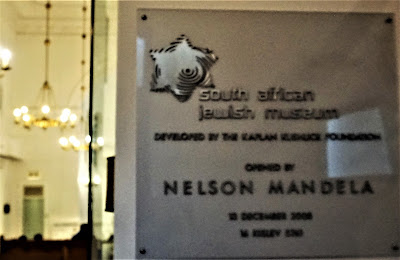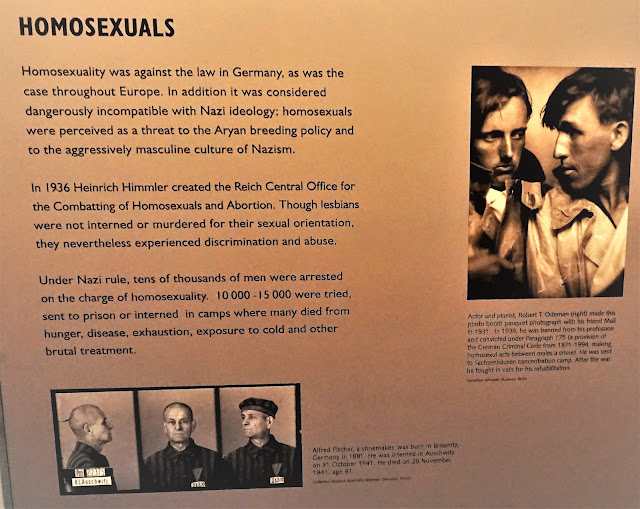The oldest Jewish congregation in South Africa, founded in 1841, is Gardens Shul (formerly Cape Town Hebrew Congregation). It is considered the "Mother Synagogue" of South Africa. It includes two buildings, an 1863 synagogue and a 1905 synagogue. (The originally 1849 building is gone.)
A guide told us that this orthodox synagogue seats 1,100. Since there are only 800 Orthodox Jews in Cape Town, it's probably never hard to find a seat.
I loved the stained glass windows, not something I usually associate with Judaism:
Close-up of two of the panes:
The spindly chandelier dropping down from the dome looks like a spider:
The property includes a museum that details the history of Judaism in South Africa:
Mandela is everywhere--or at least his name is. Apparently he was present for the opening of this museum:
The largest group of South African Jews came from Eastern Europe:
Much to the dismay of the Jewish merchants, ostrich feathers fell out of favor after World War I.
One of South Africa's most famous Jews is Ernest Oppenheimer, who was born in Germany but came to South Africa in 1902 as a diamond buyer. (He is not to be confused with J. Robert Oppenheimer, a physicist who worked on the atomic bomb.) Somehow he got control of Cecil Rhodes's De Beers company and turned it into a global monopoly. In 1921 he was knighted by King George V for his contribution to South Africa's economy. Interestingly, he converted to Anglicanism in 1935.
Another synagogue was built in Johannesburg in 1912. It was modeled after the Hagia Sophia in Istanbul:
Displays detail the history of antisemitism in South Africa:
It felt like a set for Fiddler on the Roof, complete with the tailor's shop:
When we visited, the museum had a retrospective of the Cape Town artist Max Wolpe:
 |
| Recalling Educating Rita's Playhouse Series (1985) by Max Wolpe |
This is my favorite. I would love a print of it:
 |
| Cambridge Bookshop (2005) by Max Wolpe |
I was surprised and thrilled to see that the museum has a fine collection of netsuke (Japanese miniature art):
The book is a history of De Waal's wealthy Jewish relatives, one of whom bought a collection of netsuke in Paris in the 1870s. The collection was handed down through the generations and eventually given to De Waal.
We've been to quite a few Holocaust museums that were much more elaborate than this one, but it had some unique touches, including this sweet and sad little poem:
There is some interesting information about the concepts of "race" and "racism":
. . . and some thought-provoking tie-ins to apartheid:
Also, it's not often that we see information about the Nazi persecution of groups such as the Jehovah's Witnesses and homosexuals addressed:
I also liked this display about the "Nazi Camp Universe." I have read a lot about the death camps, but know much less about the other camps, of which there were close to 42,000:
This may be the best quote I've ever read about why we should learn about and talk about the Holocaust, and I love that it comes from Desmond Tutu, the South African pastor and theologian who was a human rights activist and one of the country's most outspoken apartheid critics:
Then there was this spectacular quilt:
And what is a South African Holocaust museum without a little touch of Nelson Mandela? They have a page of his autobiography, Long Walk to Freedom, with an insightful section about Jews highlighted and then copied in his own hand:
The museum even has a video about Mandela that plays multiple times each day. You can watch it on Vimeo. Click here.












































A nice varied experience in Cape Town. The Mandela/Jew connection was fun.
ReplyDelete